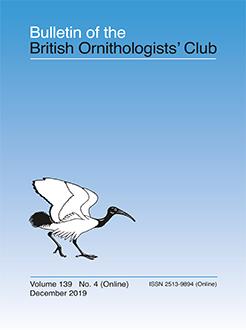Although it is a common species, almost nothing is known concerning the breeding biology of Yellow-margined Flatbill Tolmomyias assimilis. We present the first formal description of the species' nest. It was found in an open area near Manaus, Amazonas state, Brazil, and was, like the nests of other Tolmomyias species whose nests have been described, a closed structure, suspended from a branch, with an entrance tunnel.
With eight recognised subspecies, Yellow-margined Flatbill Tolmomyias assimilis is widely distributed across much of Amazonia, in terra firme and várzea forests, including anthropogenically disturbed areas. It forages alone or in pairs in the midstorey and subcanopy, searching for arthropods (Caballero & Kirwan 2019). Currently the species is considered Least Concern (BirdLife International 2019). Despite being a common species, there are no descriptions of its nest, eggs or breeding behaviour (Crozariol 2016, Caballero & Kirwan 2019). Here, we present here the first formal description of its nest, which relates to the subspecies T. a. examinatus.
On 12 January 2019, in an open area along Ramal do Italiano (02°49′30″S, 60°03′20″W), in the municipality of Manaus, Amazonas state, we observed two adult T. assimilis vocalising and, subsequently, building a nest. On this occasion, the nest consisted of a small quantity of material 2.8 m above ground among the leaves and small fruits near a drooping branch of a Vismia cayennensis (Hypericaceae) that was approximately 7 m tall (Fig. 1). Material collected by the birds was carried to the site and woven together around a trifurcation near the tip of the branch. Despite a fairly dense understorey elsewhere in the vicinity of the nest site, the area below the nest was clear of vegetation. Seven days later, nest construction had advanced considerably (it was now 160 mm tall and 80 mm wide), but the nest still lacked an entrance tunnel or egg chamber (Fig. 2). Although nests of Tolmomyias spp. often co-occur alongside nests of social insects (Menezes et al. 2014), we did not observe any in the vicinity.
On 2 February 2019, the nest had a near-vertical entrance tunnel (35 mm long with an entrance 60 mm in diameter), and a well-formed egg chamber. Its external size had also increased to 230 mm tall and 115 mm wide (Fig. 3). The main materials used to construct the nest were dark vegetable and fungal fibres, as well as tiny twigs and small dry leaves, bound together using spider's web. Our final visit was on 5 March 2019, when the nest had a total height of 260 mm, an external width of 115 mm, a tunnel 75 mm long and 56 mm in diameter at its entrance, and an egg chamber of 62.5 × 80.0 mm, measured externally (Fig. 4). No further observations were possible.
According to the classification scheme devised by Simon & Pacheco (2005), nests of the genus Tolmomyias are expected to be of the ‘closed / retort / pensile’ type. The nest of T. assimilis reported here fits this description closely. The nest appeared ready for use by early February, but by the date of our last observation it had not yet been used for breeding, despite that the birds were observed nearby on all of our visits. It is possible that the nest described here was a dormitory, used by the adults only for roosting (Skutch 1956, 1961), or that the pair was delaying clutch initiation, waiting for more conducive weather conditions or a better food supply (Stouffer et al. 2013). The nestbuilding period was characterised by heavy rainfall.
Figure 1.
One of the pair of Yellow-margined Flatbill Tolmomyias assimilis, carrying material to the nest, Ramal do Italiano, municipality of Manaus, Amazonas state, Brazil, January 2019 (Gabriel Augusto Leite)

Figure 2.
Nest of Yellow-margined Flatbill Tolmomyias assimilis with the egg chamber in formation, Ramal do Italiano, municipality of Manaus, Amazonas state, Brazil, January 2019 (Arthur Monteiro Gomes)

Figure 3.
Nest of Yellow-margined Flatbill Tolmomyias assimilis, still incomplete but with egg chamber and entrance tunnel under construction, Ramal do Italiano, municipality of Manaus, Amazonas state, Brazil, February 2019 (Arthur Monteiro Gomes)

There are two previous photographic records of this species carrying nest material. The first was in March 2009, in the municipality of Laranjal do Jari, Amapá state, Brazil (K. M. Aguiar; http://www.wikiaves.com/615884), and the second was in August 2018 (K. F. Costa; http://www.wikiaves.com/3084595), in the same area as we made our observations. In addition, there is a photograph of a purported T. assimilis nest, also from Manaus (M. R. Omena; http://www.wikiaves.com/218244), but without further information proving the species involved. In addition, there are two observations of breeding behaviour pertaining to the formerly conspecific Yellow-winged Flatbill T. flavotectus. In central Panama, on Barro Colorado Island, in April 1948, Wetmore (1972) observed an individual carrying nesting material, but did not locate the nest site, while a pair was in breeding condition in May in Colombia (Hilty & Brown 1986). In Costa Rica, at the northernmost edge of its range, the latter species breeds in April–June, building a retort-like pear-shaped bag of fine black fibres and fungal rhizomorphs, 9–21 m above ground, often near wasp nests (Stiles & Skutch 1989).
We still know surprisingly little concerning the reproduction of many Neotropical bird species, even basic data such as the structure of nests, size and colour of eggs, breeding season, and clutch size being unknown. Such information aids our understanding of species dynamics and how anthropogenic factors can affect breeding. Moreover, nests can be used to better understand phylogenetic relationships between species (Zyskowski & Prum 1999). It is therefore important that new descriptions of nests be made available, thereby providing basic knowledge about the natural history of species and generating data that can guide their conservation.
Acknowledgements
We thank Marco Crozariol and Jeffrey Podos for their reviews of the manuscript, and Izaias Miranda, Stefano Avilla and Marina Maximiano for their help in the field.






